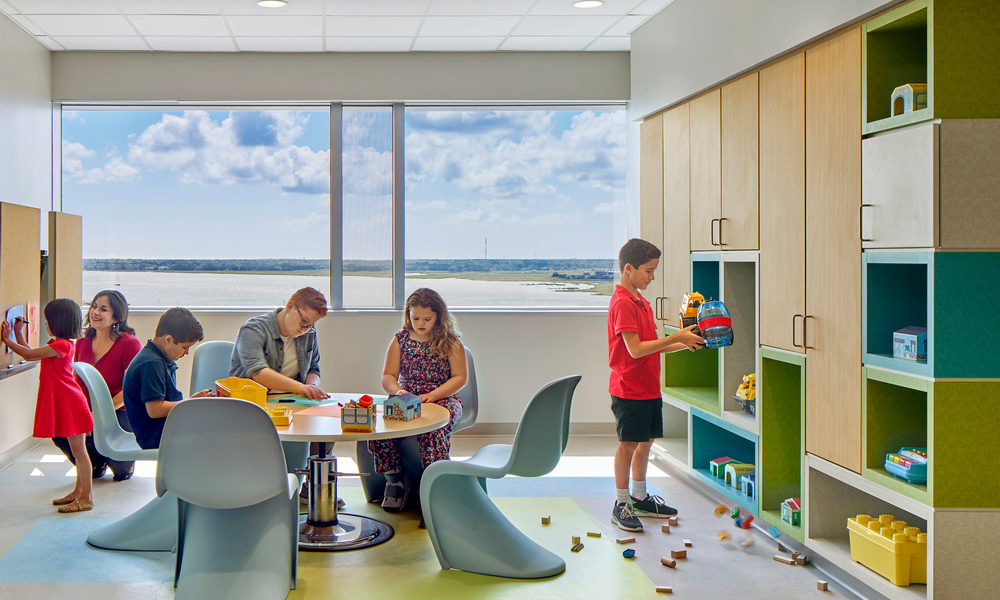 MUSC has an active and engaged Child Life program, that works closely with children for therapeutic and recreational play.
MUSC has an active and engaged Child Life program, that works closely with children for therapeutic and recreational play. 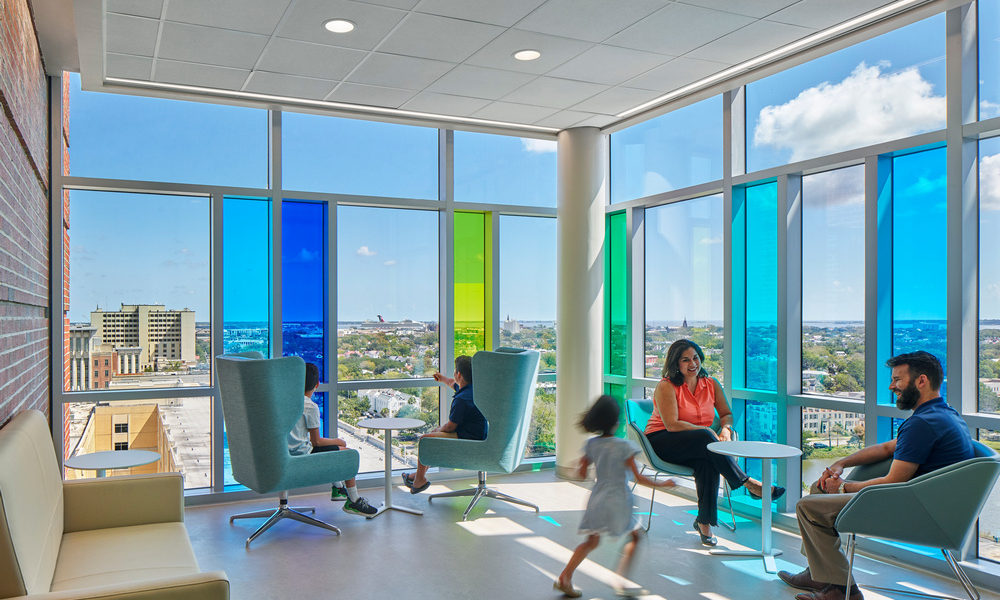 While courtyard garden lounges accommodate larger groups, these respite areas within the unit are intended to provide quiet respite for individuals or smaller groups.
While courtyard garden lounges accommodate larger groups, these respite areas within the unit are intended to provide quiet respite for individuals or smaller groups. 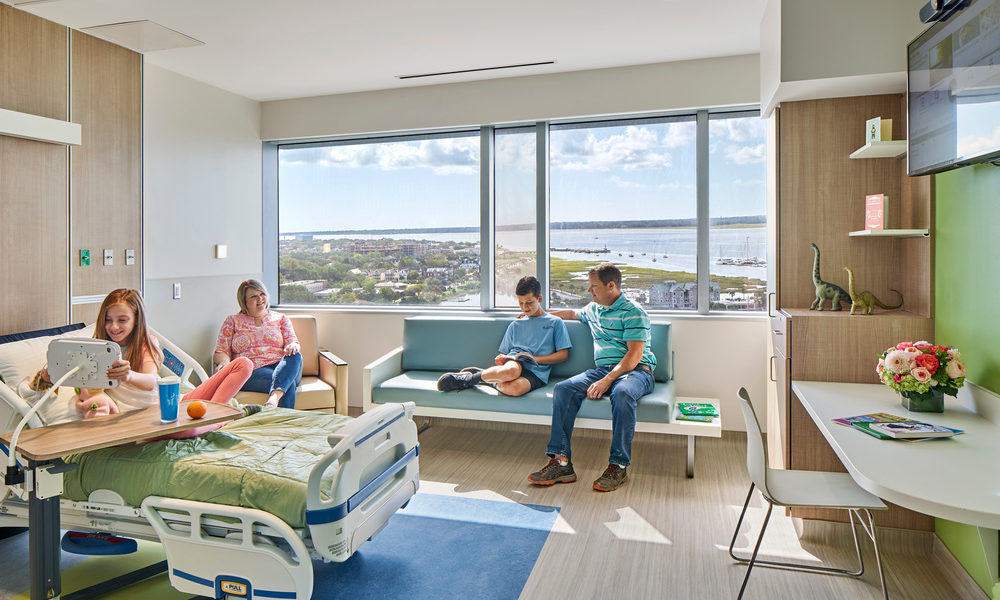 Patient bedrooms were inspired by local beach houses, with wood floor, area rugs and simplicity of furnishings. These are designed to encourage children to decorate their own space, with writable paint surface, shelves and desk.
Patient bedrooms were inspired by local beach houses, with wood floor, area rugs and simplicity of furnishings. These are designed to encourage children to decorate their own space, with writable paint surface, shelves and desk. 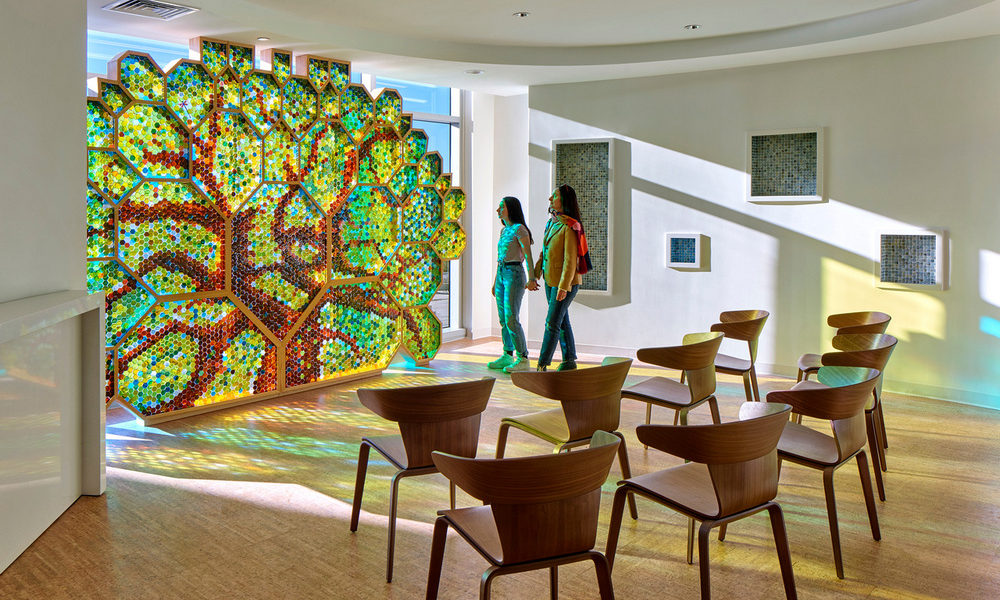 Located in the Meditation Room, this Bob Hines glass, wood-framed fractal patterned interpretation of Angel Oak, a majestic local Southern Live Oak that is estimated to be at least 400 years old.
Located in the Meditation Room, this Bob Hines glass, wood-framed fractal patterned interpretation of Angel Oak, a majestic local Southern Live Oak that is estimated to be at least 400 years old. 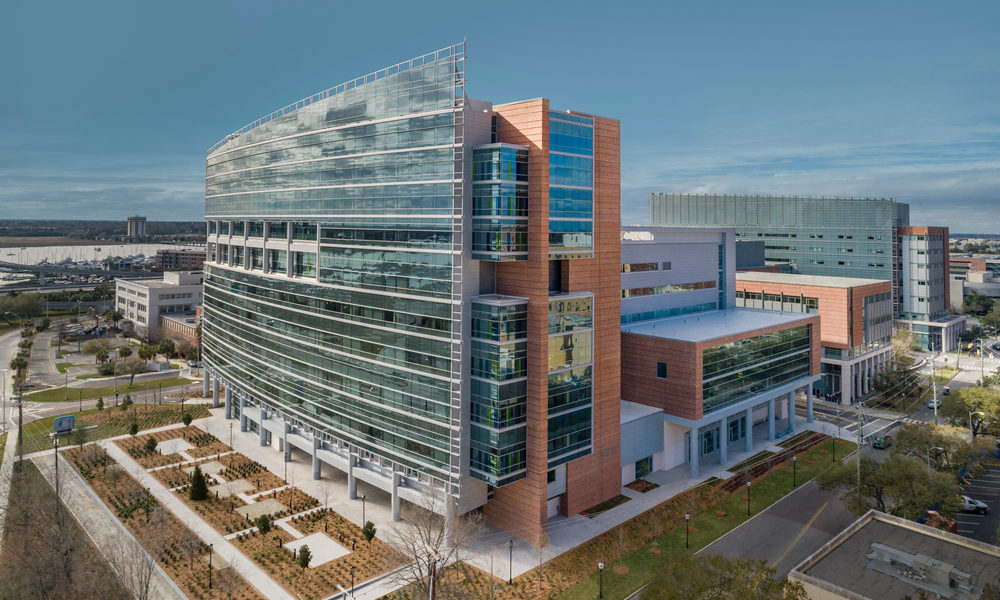 MUSC Shawn Jenkins Children Hospital.
MUSC Shawn Jenkins Children Hospital. Subscribe Now
Landmark Facility at Medical University of South Carolina Aspires to Set New Precedents for Inclusive Healthcare Design
Aspiring to be of one the country’s most autism-friendly hospitals, the new Medical University of South Carolina Shawn Jenkins Children’s Hospital and Pearl Tourville Women’s Pavilion aims to set a new precedent for inclusive healthcare design. The landmark facility rethinks traditional norms with a design that responds to the complex needs of both patients, staff and the local community.
Designed by Perkins&Will, in collaboration with associate architect McMillan Pazdan Smith Architecture, and built by Robins & Morton, Cumming and Brownstone Construction, the new 625,000-square-foot facility provides integrated medical care for children, as well as obstetrical services for women. Located in Charleston, South Carolina, MUSC opened its doors to patients early this year after a collaborative process that included clinical and administrative leadership, Child Life, the MUSC Patient Family Advisory Council and Youth Council.
From the outside-in, the new facility is designed to be both inclusive and joyful, anchored by a welcoming south façade that incorporates an iconic glass “sail” feature, oriented to the waters of Charleston Bay where the Ashley and Cooper Rivers merge.
The two-story main lobby was inspired by Courtyard Garden in historic Charleston. Cypress paneling was created from recovered pilings that held up the site’s previous hospital, the McClennan Banks Building.
Overlooking the main lobby, it was critical for the design team to create a space of calm and reduce environmental stressors throughout the interior.
Autism-friendly design
The design team harnessed feedback from parents with children on the autism spectrum to deliver a full-sensory design response, including the removal of potential triggers that could create an overwhelming environment. Instead, the design prioritizes calming the senses with a lack of visual clutter, carefully thought-out travel paths, scale and lighting controls for patients to adjust as needed. Acoustic considerations were also made to the interior, including removal of automatic flushers and hand dryers in bathrooms.
Designers worked with MUSC’s Child Life program to create a sensory room dedicated to patients on the spectrum. In addition, a roof garden/play area provides a place for children and families to connect with nature and find a place of respite.
The Child Life Play Atrium on the seventh floor showcases a custom mural by Sisal Creative, a team of Charleston artists, and features themes of the Lowcountry comprised of small objects for children to “find” like an “I-spy” game.
Stories of the Lowcountry
The building’s architecture, interiors and surrounding landscape are integrated and rooted in MUSC’s theme “Stories of the Lowcountry. The exterior features plants from the Charleston area and the paths in the roof garden are inspired by the marshes of the Lowcountry of the area. The building’s glass façade was intended to filter through light, creating illuminated patterns on the brightly colored interiors. The building’s form and function were also purposefully articulated to maximize views of the city and the waterfront below.
Moving indoors, neutral color palettes inspired by sweetgrass baskets and traditional haint blue hues in the elevator lobby provide a playful nod to Charleston’s history. Multicolor room fronts pay homage to the city’s celebrated Rainbow Row. Within the hospital rooms, the use of textures and tones pays tribute to Charleston’s beach houses, creating a feeling of respite and recovery for children.
While Courtyard Garden lounges accommodate larger groups, these respite areas within the unit are intended to provide quiet respite for individuals or smaller groups.
The design team worked with local artists, SDCO Partners, to create graphic walls. Each floor features a graphic representation and distinct color identifying the theme of that floor, enhancing a sense of place and help wayfinding.
Anchored in empathy
The MUSC campus offers innovative and rare healthcare solutions that are particularly sensitive to women and children while supporting healing. This includes 12 dedicated couplet care rooms where mother and neonate are treated by the same dedicated nursing team, providing a more family centered approach to patient care. The design team was also mindful to create a calm and nurturing environment that is appropriate for women experiencing high-risk pregnancies.
Perkins&Will sought to relate to children in an authentic and meaningful way, rather than project an adult’s view. The resulting space is one that avoids clichés, instead, embracing a sense of wonder through discrete design interventions and soft architectural moves.
Harnessing the healing power of nature
Patients are encouraged to find peace in nature with the child life play deck while staff can retreat to the staff respite terrace.
The design purposefully and strategically connects the interiors with the outdoors as caregiver well-being is important, and making access to fresh air and daylight near patient units possible. Large porches accented by columns and biophilia are signature elements providing shaded outdoor living areas. Meanwhile, courtyard gardens with arched openings and hedges inform lobby and waiting areas.
The Staff Respite Terrace offers caregivers an area for solitude via back of house offstage access on the eighth floor.
The family dining terrace near family amenities (cafeteria, conference rooms, meditation chapel, child life play roof deck and atrium space) adds an outdoor element on the seventh floor.
A whimsical play on the courtyard garden arches creates niches for play areas in the waiting lounge area.
Resiliency by design
Situated on former marshland, the facility prioritizes resiliency in its design response with all patient care areas placed above designated flood elevation.
Exteriors were strategically selected to meet hurricane-force winds and resist the impact of flying debris. The ground floor was equipped with flood-proof panels and emergency generators out of reach of floodwaters among many other design features for other potential natural disaster events.
The building is set back from the street, creating an “urban green space,” which is a gesture to Charleston’s green civic gardens. A low-seat wall around three sides defines this space and elevates the planting above low-level floods to improve the resiliency of the landscape with native plants selected to aid in the rising tide flows.
Exterior photography: James Steinkamp
Interior photography: Halkin Mason
Tags: Architecture, autism-friendly, Construction, inclusive healthcare design
Posted January 13, 2021
More Articles:
- Coverings 2024
Apr 22, 2024 – Apr 25, 2024 - Hospital, Outpatient Facilities & Medical Office Buildings Summit
Apr 25, 2024 – Apr 25, 2024 - CxA Workshop & Exam
Apr 29, 2024 – Apr 30, 2024 - EMP Seminar & Exam at CxEnergy 2024
Apr 29, 2024 – Apr 30, 2024 - CxEnergy
Apr 29, 2024 – May 2, 2024 - PHCC West 2024
Apr 29, 2024 – May 2, 2024 - Lean in Design Forum 2024
May 1, 2024 – May 2, 2024










